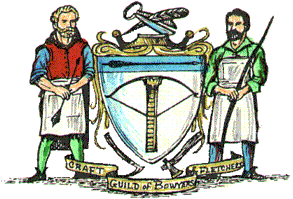History of Medieval Guilds
 The groups, or fraternities of craftsmen from and by whom the medieval Guilds were formed represented the complex pattern of medieval life. Industries that were essential both to support life, and inter alia the smooth running of the Country's economy, needed regulation by Authority to control production, and above all, quality. For maintenance of proper standards of workmanship was an early tenet of the first Guilds.
The groups, or fraternities of craftsmen from and by whom the medieval Guilds were formed represented the complex pattern of medieval life. Industries that were essential both to support life, and inter alia the smooth running of the Country's economy, needed regulation by Authority to control production, and above all, quality. For maintenance of proper standards of workmanship was an early tenet of the first Guilds.
The term 'livery', applied to the various Companies of individuals comes from feudal times, when, with royal approval an allowance of clothing was given by various bodies, barons, monastries" colleges, or guilds to their own retainers to identify them as 'belonging'.
The Guilds were permitted to wear livery at a time when others were not and were thus known as 'livery Companies'. The Companies by which the present Craft Guild is recognised, are the Worshipful Company of Bowyers, and the Worshipful Company of Fletchers.
There is an additional association with the Blacksmith's Company through the Guild's two Master arrowsmiths. The Ancient Company of Longbowstringmakers is now defunct, although the Craft Guild does include three Stringer amongst its membership. The term 'worshipful' referred not just to the God-fearing nature of the Guilds and their membership, an aspect which might be taken more or less for granted having regard to the time that they were formed, but in its earlier sense, 'worth-ship', reflecting the respect and reverence in which the Guild was held.
The modern Craft Guild to some extent follows the form of the earlier Companies. They had, and still have a Master, or 'Prime Warden' as their figurehead, - in modern terms the Chairman, who serves for one or two years. To help and advise him in his deliberations there is a Court of Assistants. They are in effect the Governing Body which decides policy. Looking after the day to day running of the Company is the Clerk.
The present Guild has a Warden and an under-Warden with five Assistants, forming a Court of seven. The Warden serves for two years, when he returns to the body of the Guild, being replaced by the under-Warden. The position of under-Warden is taken by an Assistant, and a member of the Guild is then elected to replace him and maintain the numbers of the Court. Thus, a newly entered member of the Court might expect to become Warden in eleven years.
Quality and its maintenance was a prime object of the early Courts and remains a principal cornerstone of the present Craft Guild. However whereas the early Companies had teeth, and were able to discipline errant members by fine, the modern Guild has no such teeth. Quality is maintained by personal pride, and the obvious commercial disadvantage of poor worksmanship.
In an endeavour to ensure quality work, applicants for membership serve an 'apprenticeship' before election to full Guild status after presentation of their Masterpiece. Both the Worshipful Company of Bowyers and of Fletchers award their own Certificates for excellence of workmanship, which further adds to the maintenance of high quality.
From the foregoing it will be recognised that the Craft Guild of Traditional Bowyers & Fletchers is endeavouring to raise the standard of craftmanship, and therefore earnestly recommends the work of its members to the discerning archer.